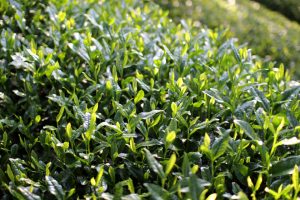
What do Gokou, Asahi, Ujihikari, and Samidori cultivars have in common?
First of all, they come from Kyoto prefecture. Second, they are used for gyokuro and tencha. Finally, they aren’t registered.
Let’s take a closer look at the Gokou (ごこう) cultivar in this post.
About the Gokou tea cultivar
I had a hard time researching this cultivar because there’s few information available.
This must be because it isn’t registered, although it’s not a rare cultivar.
It originated from a seed of a native plant in Uji. Many such seedlings where raised and Gokou was selected as the best of them in 1953.
This was done at the Kyoto Prefecture Tea Industry Research Institute (京都府茶業研究所).
Unfortunately, I couldn’t find the reason why this cultivar wasn’t registered in the official list.
Characteristics of Gokou
Like many of the tea cultivars developed in the Uji region, Gokou is meant for gyokuro and tencha (which ultimately results in matcha).
That is, this cultivar gives good results when using the shaded cultivation method.
Its plucking period is three days later than the Yabukita cultivar.
This cultivar is strong against cold weather and has medium resistance to anthracnose.
The buds of Gokou have a pale green color and few wrinkles. Also, the yield is about the same as Yabukita.
When processed, the tea has a very notable aroma which is best if the tea leaves were shaded.
Gokou’s finished tea leaves have a dark green color and a strong umami flavor. Again, this characteristic works best when shaded.
It’s often used for gyokuro and matcha in Kyoto prefecture. As a cultivar for this types of tea, the quality is very good.
A sencha made from this cultivar is quite rare, and while being notably different it may not result in a superior sencha.
As with other tea cultivars developed in Kyoto, Gokou works well for this prefecture’s soil and climate.
While I was in Uji, I remember that the owner of a tea store said that Gokou and Ujihikari made the best cultivars for the local matcha.
From my very limited experience, I can tell you that you can’t go wrong with a matcha from Uji made with Gokou.
Sources:





December 22, 2016
Great information because there is so little information on Kyoto cultivars like Gokou, Asahi and Samidori. Thank you! Now I look forward to some information on the latter two.
December 22, 2016
Hi Lochan
Thanks for your comment, and for your help in finding what little information is available on these cultivars.
April 21, 2017
I’m told the Gokou cultivar is gaining in popularity for sencha, especially with young people in Japan, as the Japanese manager of the tea shop I work at says. We carry a sencha made from Gokou here from the producer Osada that’s quite tasty, but then again I think I qualify as a younger person.
Any trends you’re seeing w/ this cultivar? Perhaps the Medellin youth are drinking it between discoteca trips in pargque lleras to keep the party going…
April 21, 2017
Thank you for your comment.
Actually I’ve never had a sencha from Gokou, so I can’t give you my opinion regarding the taste.
I don’t live in Medellin, but I see that you have been there. Good joke, only a small number of people drink loose leaf tea in my country, let alone know about Japanese cultivars 🙂